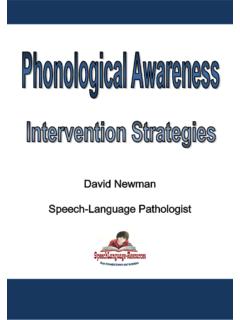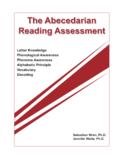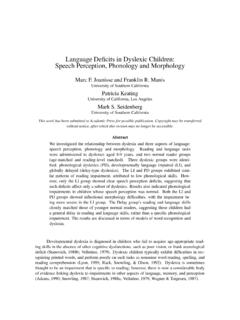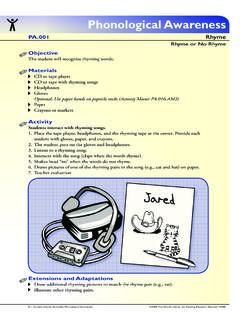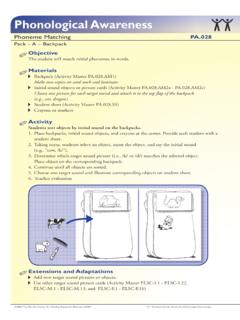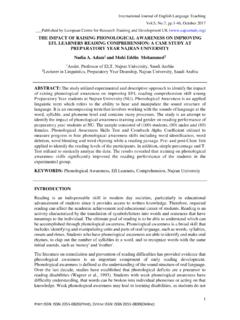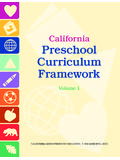Transcription of Dyslexia: Why Is This Diagnosis so Challenging?
1 dyslexia : Why Is this Diagnosis so Challenging? Linda J. LombardinoDepartment of School Psychology, Special Education, and Early Childhood Studies,University of FloridaGainesville, FLLaurie M. GaugerDepartment of Speech Language and Hearing Sciences, University of FloridaGainesville, FLFinancial Disclosure:Linda J. Lombardino is a Professor at the University of Florida. Laurie is a Clinical Speech-Language Pathologist at the University of Disclosure:Linda J. Lombardino has previously published in the subject M. Gauger has no nonfinancial interests related to the content of this , the most commonly identified learning disability, frequently goes unidentified inschool age children, especially when children perform adequately on high stakes tests.
2 Thepurpose of this paper is to aid speech-language pathologists (SLPs) in diagnosing childrenwho have dyslexia . We address profiles of behavioral strengths and weaknesses that arecharacteristic of these children and we present sample evaluation profiles of a few childrenwith dyslexia that we have tested over the past DyslexiaThere has been a resurgence of interest in reading difficulties over the past two decades. Agreat deal of attention has been directed toward best educational practices for teaching reading(National Reading Panel, 2000; Moats, 2000) and best clinical practices for identifying and treatingchildren with written language disabilities (Bishop & Snowling, 2004; Catts & Kamhi, 2005;Scarborough, 1990, 1998; Snowling & Hulme, 2012; Stanovich, 2000; Woodruff & Lian-Thomson,2007).
3 Reading difficulties have been found to affect around 80% of the children who are identified ashaving a learning disability (Lerner, 1989). While is it commonly acknowledged that a disproportionatenumber of the school-age population are reading belowthemasterylevelexpectedfortheirresp ectivegrades (National Reading Panel, 2000), the root of clinicians difficulties in identifying and treatingchildren with reading difficulties is, in large part, due to our lack of differentiation among types ofreading difficulties within this heterogeneous group of children who struggle with reading (Fletcher& Lyon, 2008; Pennington, 2006). Numerous researchers have validated that reading difficultiescan result from varying underlying causes ( , impoverished environment, disorder in languageproduction and/or comprehension, disorder of phonological decoding and encoding; Fletcher &Lyon, 2008; Joshi & Aaron, 2008).
4 While some children fail to acquire adequate reading skills due to a lack of opportunity andpoor instruction, others fail to succeed in reading in spite of good environmental supports andoverall adequate intellectual abilities because of disruptions in one or more domains of cognitiveprocessing (Stanovich, 2000). It is this latter group of children who should be identified as havinga reading disability. As noted in a recent paper by Snowling and Hulme (2012), reading disabilitiescan be broadly classified into two types: (a) dyslexia a reading disorder that results from low leveldifficulties in processing phonological and orthographic segments that interfere with the student sability to learn and remember sound-letter associations for reading and spelling and to developautomaticity for word-level reading and spelling; and (b)reading comprehension deficit a readingdisorder that results from deficits involving semantic, syntactic, and pragmatic skills needed to98 Downloaded From: by Julie Giaccone on 09/24/2015 Terms of Use: meanings in spoken and written language.
5 Both types of deficits can occur with varyingdegrees of impairment and are often associated withco-morbid difficulties in attention and processingspeed (Pennington & Bishop, 2009). Research shows that the more precise the remediation targetsthe specific deficits of the reader ( , working memory, phonological processing), the better theoutcome (Aaron, Joshi, Boulware-Gooden, & Bentum, 2008; Morris et al., 2010). this paper addresses the challenges involved in diagnosing dyslexia , the most commonlearning disability. The Diagnosis of dyslexia is not confined to a specific profession. While oftenthe Diagnosis is made by an educational diagnostic team or school psychologist, speech-languagepathologists (SLPs), and other professionals who have been well trained in the differential diagnosisof spoken and written language disabilities are often in a position to identify children with thisspecific learning affects approximately 7 10% of the school age population in all literate countries(Georgiou, Papadopoulos, Zarouna, & Parrila, 2012; S.)
6 E. Shaywitz, Shaywitz, Fletcher, & Escobar,1990). While there is no universal definition of dyslexia , researchers who study reading disabilitieshave put forth a definition of dyslexia for the purpose of differentiating dyslexia from other typesof learning disabilities. dyslexia is a neurodevelopmental reading disability that often runs infamilies and is characterized by primary deficits in word-level reading, decoding, spelling, andoral reading fluency that interfere with reading comprehension and other domains of academicachievement in spite of adequate listening comprehension, intelligence, and literacy learningopportunities, and instruction (Lyon, Shaywitz, & Shaywitz, 2003; Vellutino, Fletcher, Snowling,& Scanlon, 2004).
7 The reader may wish to refer to the definition adopted by the U. S. NationalInstitutes of Child Health and Development (Lyon et al., 2003).TheDiagnostic and Statistical Manual of Mental Disorder (DSM) published by the AmericanPsychiatric Association, is the most widely used international source for classifying mental andneurodevelopmental disorders. In the DSM-IV (American Psychiatric Association [APA], 2000), dyslexia was assigned a specific diagnostic code ( ); however, in the recent DSM-5 (APA,2013), dyslexia no longer has a diagnostic code of its own and is classified under the more generaldescription of a specific learning disorder (SLD), which includes disorders of reading, writing, andmathematics.
8 Readers are referred to an article by Tannock (2014) on the implications of DSM-5changes for clinicians and to a recent paper by Snowling and Hulme (2012) on the difficulties withpast and present classifications of reading disorders in the Bases of DyslexiaSeveral theories have been proposed in an attempt to explain the varied cognitive profilesof persons with dyslexia yet none has adequately accounted for the multiple patterns of deficitsobserved clinically or in research studies (Fisher &DeFries, 2002; Heim & Grande, 2012; Pennington,2006; Peterson & Pennington, 2012). The most widely cited theories posit that some type of deficit inphonological processing lies at the basis of dyslexia (Stanovich, 1988; Vellutino et al.)
9 , 2004). Someresearchers propose that dyslexia results from the poor quality of the phonetic representations ofsounds in the language centers of the brain (Goswami, 2002), while others suggest that the qualityof the phonetic representations are intact but faulty mechanisms interfere with the transmissionof sounds to areas of the brain where higher order verbal and visual processing occur (Boets et al.,2013; Ramus & Szenkovits, 2008). dyslexia runs infamilieswithaheritabilityrateofaround5 0 60%(Pennington & Olson, 2005).However, studies of individuals with dyslexia show that this developmental disorder is notlimited to phonological processing deficits that impact word-reading, spelling, and reading fluencybut is also associated symptoms in more fundamental cognitive processes such working memory(Gathercole & Alloway, 2004), attention (Valdois, Bosse, & Tainturier, 2004), and speed of processing(Nicolson & Fawcett, 1994).
10 Table 1, adapted from Lombardino (2012), provides a list of the typicalpatterns of strengths and weaknesses commonly observed in individuals who have dyslexia . It isimportant to note that not all individuals who have dyslexia manifest all of these supports the cogent tenets of some researchers that dyslexia manifests in multiple patterns99 Downloaded From: by Julie Giaccone on 09/24/2015 Terms of Use: deficits, some of which are shared with other developmental disorders such as speech andlanguage deficits and attention deficits (Pennington, 2006; Peterson & Pennington, 2012). Examplesof differences in the behavioral profiles of individuals diagnosed with dyslexia follow: Two students have notable deficits in word decoding, spelling, and reading fluency yetone student has a low average phonemic awareness score on an elision task and asevere deficit in rapid naming, and the other shows mild deficits in both phonemicawareness and rapid naming.


